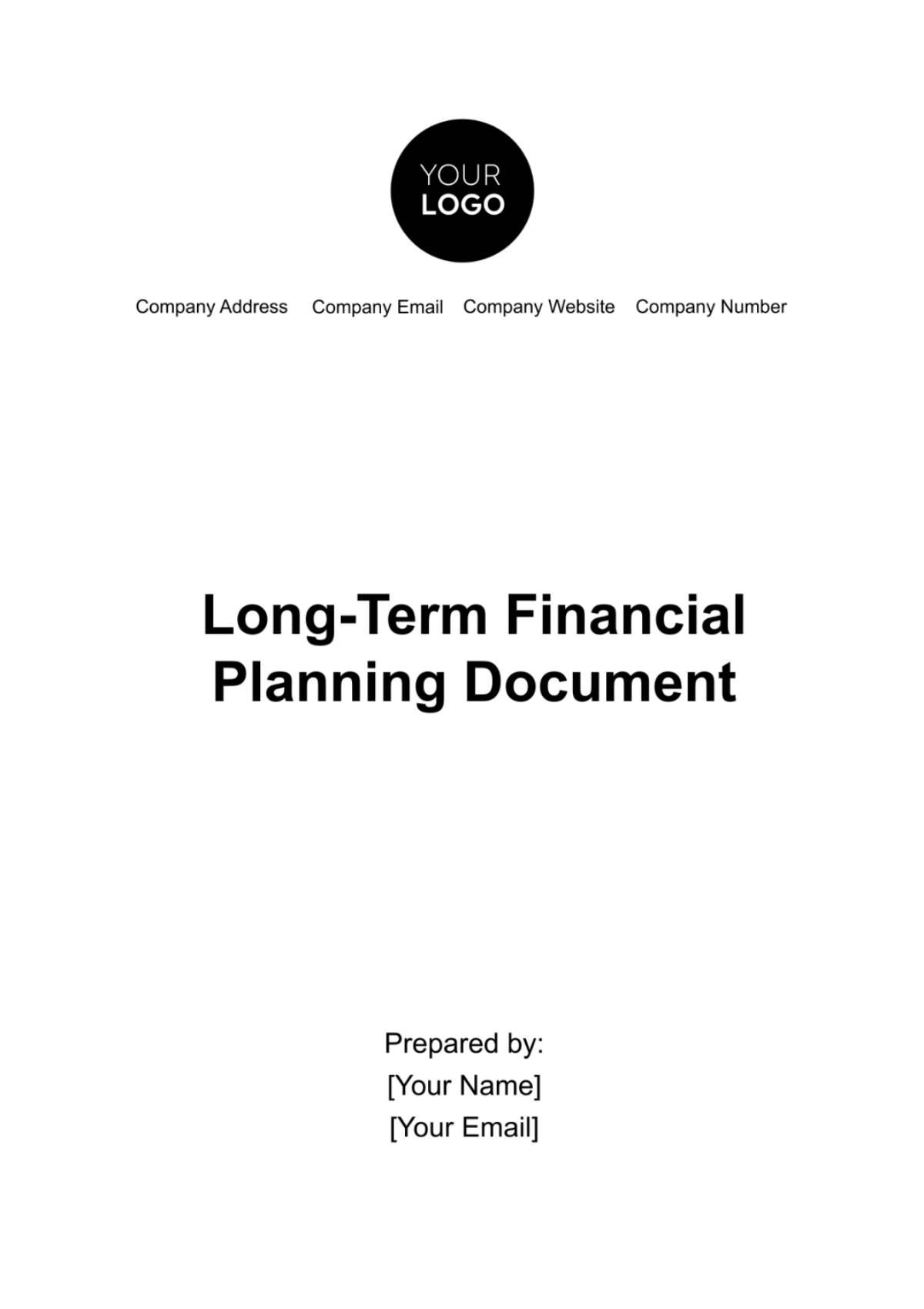Free Long-Term Financial Planning Document

I. Executive Summary
This planning document is the strategic cornerstone for [Your Company Name], designed to guide our journey over the next [10] years. It is a financial blueprint, carefully crafted to steer the company towards its overarching vision of robust growth, market leadership, and sustained financial health. The plan balances ambitious growth objectives with prudent financial management, positioning [Your Company Name] to capitalize on emerging opportunities while navigating potential market uncertainties. This forward-thinking approach ensures that we are not just reactive to market changes but are proactively shaping our financial future.
Key Long-Term Financial Objectives
Our primary financial ambition is to secure a steady annual revenue growth of [20]%, a target we believe is achievable through strategic market expansion and product innovation. In parallel, we are committed to maintaining a robust cash flow, which is vital for operational flexibility and investment opportunities. Additionally, we aim to enhance our market share by [10]%, a goal that will be pursued through aggressive marketing strategies, customer engagement, and service excellence. Our approach to achieving these objectives is grounded in data-driven decision-making and continuous process optimization to improve efficiency and profitability.
Summary of Strategic Financial Goals
In the upcoming years, [Your Company Name] will prioritize diversifying revenue streams to mitigate risks associated with market volatility. This includes exploring new market segments and developing innovative products or services. We also target reducing operational costs by [20]% through streamlined processes, technological advancements, and optimizing resource utilization.
A key focus will be on investing in research and development to foster innovation, keeping us ahead of market trends and competition. Concurrently, we will refine our capital allocation strategies, ensuring investments are aligned with shareholder expectations and long-term value creation. This holistic approach to strategic financial planning is designed to bolster [Your Company Name]'s position as a market leader and secure its financial future.
II. Market Analysis and Economic Outlook
This section of the Long-Term Financial Planning Document provides a granular analysis of the market dynamics, economic environment, and competitive landscape.
A. Industry Trends and Projections
Detailed analysis of current industry trends, future predictions, and potential disruptors. We will examine how digital transformation and emerging technologies may redefine our industry and create new opportunities.
Aspect | Trend/Projection | Impact on [Your Company Name] |
Digital Transformation | Accelerated adoption of digital technologies across industries. | Opportunities for digital product development and market expansion. |
Consumer Behavior Shifts | Increasing preference for sustainable and ethical products. | Potential to innovate in product offerings and marketing strategies. |
B. Economic Factors Impacting the Business
An in-depth review of macroeconomic factors like fluctuating interest rates, inflation trends, and geopolitical events. These factors will be assessed for their potential impact on our business operations and financial performance.
Factor | Description | Potential Impact on [Your Company Name] |
Interest Rates | Fluctuations in interest rates impacting borrowing costs. | Affects the cost of capital and investment decisions. |
Inflation Trends | Changes in inflation rates affecting purchasing power. | Impacts pricing strategies and cost management. |
Geopolitical Events | Political instability and trade policies in key markets. | Risks and opportunities in international operations and supply chains. |
C. Competitor Financial Strategies and Positioning
These strategies will help us identify gaps and opportunities for [Your Company Name] to exploit. These are great for business growth.
Competitor Aspect | Description | Strategic Considerations for [Your Company Name] |
Financial Health | Competitors' revenue growth, profitability, and debt levels. | Identify financial strengths and weaknesses to benchmark performance. |
Investment Strategies | Competitors' areas of investment such as R&D, acquisitions. | Insights into market trends and potential areas for investment. |
Market Positioning | Competitors' market share, customer base, and brand positioning. | Opportunities to differentiate [Your Company Name] and gain market share. |
III. Long-Term Financial Goals and Objectives
This section outlines the ambitious yet achievable financial goals and objectives of [Your Company Name]. It includes specific targets for revenue growth and profitability, a strategic plan for capital expenditures, and a balanced approach to managing debt and equity, all aimed at enhancing the company's financial strength and market position over the long term.
A. Revenue and Profit Targets
Set ambitious yet attainable targets for revenue growth and profit margins, aiming for an increase of [number of percentage]% annually. These targets will be aligned with our overall business expansion and innovation plans.
Financial Year | Revenue Growth Target | Profit Margin Target |
Year 1 | [8%] | [15%] |
Year 2 | ||
Year 3 | ||
Year [n] |
Revenue Growth Target: In the first year, our aim is to increase our revenue by [8%]. This will be achieved by expanding into new markets, launching new product lines, and enhancing sales strategies.
Profit Margin Target: We aim to achieve a [15%] profit margin by optimizing operational efficiency, reducing production costs through streamlined processes, and improving the product mix towards higher-margin offerings.
B. Capital Expenditure Plans
Outline a strategic plan for capital investments focusing on technological advancements, infrastructure upgrades, and talent acquisition to support our long-term goals.
Area of Investment | Description | Planned Investment |
Technological Advancements | Investing in new technologies and digital infrastructure. | $[10,000] |
Infrastructure Upgrades | Enhancements to physical facilities and equipment. | |
Talent Acquisition | Recruiting and training skilled personnel in key areas. | |
Research and Development | Funding innovation and development of new products/services. |
C. Debt Reduction and Equity Growth Strategies
Implement a balanced approach to reduce our debt-to-equity ratio by [80]% over the next [10] years, enhancing our financial stability and investor attractiveness.
Financial Year | Debt Reduction Target | Equity Growth Strategy |
Year 1 | [ total debt by 5%] | [ Focus on reinvesting profits to increase equity] |
Year 2 | ||
Year 3 | ||
Year [n] |
Debt Reduction Target: Our objective for the first year is to reduce our total outstanding debt by [5%]. This will be approached by reallocating cash flows towards debt repayment and renegotiating terms with creditors for more favorable conditions.
Equity Growth Strategy: The strategy focuses on increasing shareholder equity by reinvesting a portion of the profits back into the company. This reinvestment will be directed towards areas that promise long-term growth and stability, such as research and development and market expansion.
IV. Investment Strategies and Asset Management
This section outlines [Your Company Name]'s approach to investment and asset management. It includes a strategic asset allocation plan for long-term growth, a comprehensive risk management framework, and identifies future investment priorities. These strategies are designed to maximize returns, minimize risks, and align with our long-term objectives.
A. Asset Allocation for Long-Term Growth
A strategic plan for asset allocation will be developed, focusing on a balanced mix of high-growth and stable investment options to ensure optimal long-term returns.
Asset Category | Allocation Strategy | Objective |
Equities | Allocation to a mix of domestic and international stocks | High-growth potential |
Fixed Income | Investment in government and corporate bonds | Stability and regular income |
Real Estate | Investment in commercial and residential properties | Diversification and steady returns |
Emerging Markets | Allocation to emerging market equities and debt | High-growth potential in new markets |
Alternative Investments | Investment in private equity, hedge funds, etc. | High returns and diversification |
B. Risk Management and Diversification Strategies
Establish a comprehensive risk management framework to mitigate financial risks through diversification, regular market analysis, and adopting advanced risk assessment tools.
Strategy | Description | Implementation Method |
Market Diversification | Spread investments across various markets and sectors | Diversify across geographic and industry lines |
Asset Class Diversification | Mix of stocks, bonds, real estate, etc. | Balance between risk and return |
Regular Portfolio Rebalancing | Adjusting the portfolio to maintain the desired risk level | Periodic review and adjustment based on market conditions |
Use of Hedging Instruments | Use derivatives to offset potential losses | Implement strategies like options and futures to mitigate risks |
C. Future Investment Opportunities and Priorities
Identify and prioritize future investment opportunities in new markets, technologies, and sustainable practices that align with our long-term strategic goals.
Opportunity Area | Description | Strategic Importance |
Technology Sector | Investment in high-growth tech companies and startups | Capitalize on digital transformation trends |
Green Energy | Investments in renewable energy and sustainable practices | Align with global sustainability trends |
Emerging Economies | Focus on markets with high growth potential | Exploit untapped markets for expansion |
Healthcare Innovations | Investment in healthcare technology and services | Benefit from advancements in healthcare and aging populations |
V. Financial Risk Assessment and Mitigation
In this section, we focus on identifying, assessing, and mitigating financial risks to safeguard [Your Company Name]'s assets and earnings. This involves analyzing various risk factors, developing comprehensive risk mitigation strategies, and preparing contingency plans to handle economic uncertainties and market shifts.
A. Identification of Potential Financial Risks
A thorough analysis of potential financial risks is critical for [Your Company Name]. We will use advanced analytical tools to assess risks such as market volatility, which can impact investment returns; credit risk, pertaining to the ability of borrowers to meet their obligations; and operational risks, including supply chain disruptions or technological failures. This analysis will involve studying historical data, market trends, and predictive modeling to identify and understand the potential impact of these risks on our financial stability.
B. Strategies for Risk Mitigation and Management
Developing robust strategies to mitigate these identified risks is key to protecting [Your Company Name]'s financial health. Investment diversification is a primary tool in this effort, spreading assets across various classes and sectors to minimize the impact of market fluctuations. Strong credit policies, including comprehensive credit checks and setting appropriate credit limits, will help manage credit risk. Additionally, maintaining operational redundancies and implementing effective operational controls will reduce the likelihood and impact of operational failures.
C. Contingency Plans for Economic Downturns or Market Changes
Preparing for economic downturns or significant market changes is essential for ensuring the resilience and adaptability of [Your Company Name]. Our contingency plans will include strategies like building cash reserves to provide a buffer during economic slowdowns, flexible operational plans to quickly adapt to market changes, and dynamic financial modeling to anticipate and prepare for various economic scenarios. These plans will enable us to maintain financial stability and operational continuity even in challenging times.
- 100% Customizable, free editor
- Access 1 Million+ Templates, photo’s & graphics
- Download or share as a template
- Click and replace photos, graphics, text, backgrounds
- Resize, crop, AI write & more
- Access advanced editor
Craft a robust financial future with Template.net's Long-Term Financial Planning Document Template. This editable and customizable tool provides a roadmap for sustainable growth. Tailor your strategy effortlessly with our AI Editor Tool, ensuring adaptability to changing landscapes. Secure your financial success with ease and precision.





























